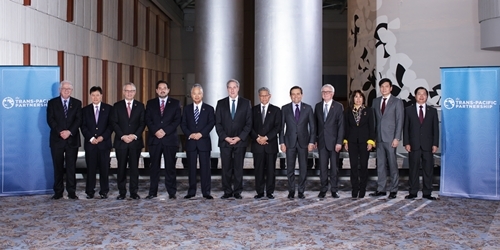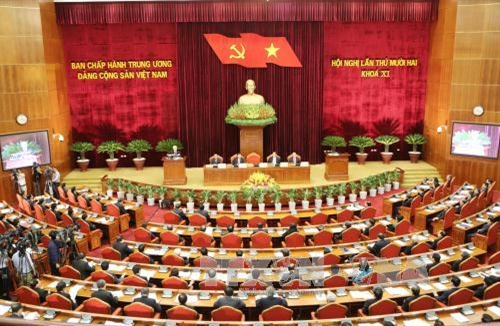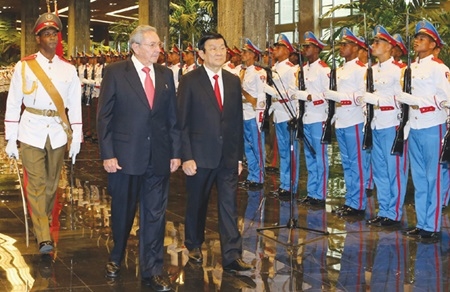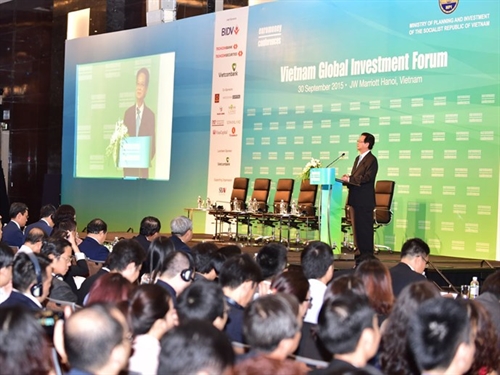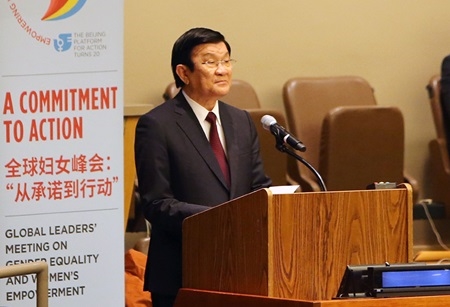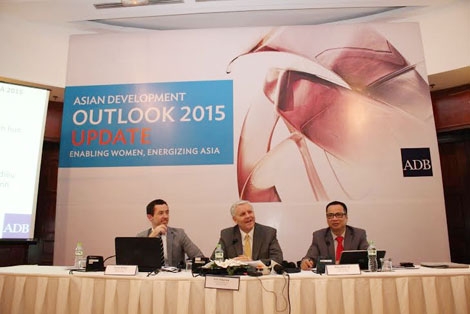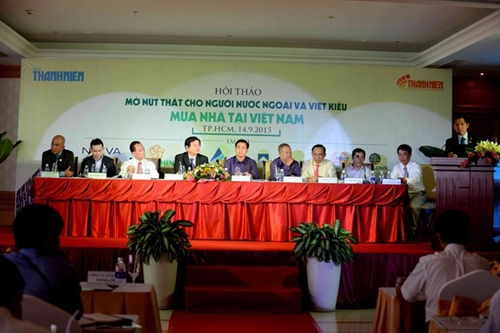Trade ministers from the 12 Trans-Pacific Partnership (TPP) member countries reached final consensus on the world’s largest free trade agreement at Atlanta, the US, on October 5. Vietnam News Agency asked Vietnamese Minister of Industry and Trade Vu Huy Hoang about the agreement.
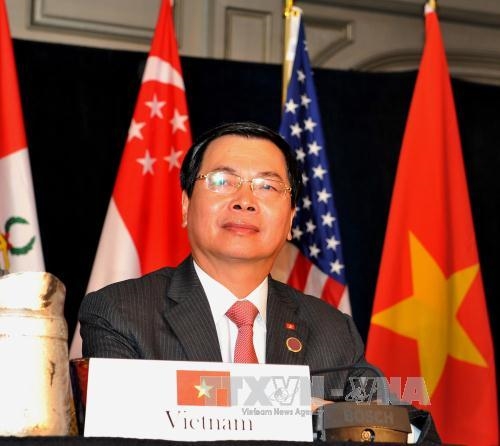 |
| Minister of Industry and Trade Vu Huy Hoang at the press conference in Atlanta, the US__Photo: VNA |
The TPP deal has been struck after five years of negotiations. What does Vietnam have to do now?
After ending negotiations on the TPP deal, all TPP countries will review legal procedures to prepare for the official signing of the TPP agreement, and then the TPP agreement needs to be ratified by the parliaments of the TPP countries.
The process needs at least 18 months. That period offers a good chance for the TPP to achieve certain conditions for implementing the deal.
For Vietnam, based on the general agreement among TPP countries, the Ministry of Industry and Trade and the Government’s TPP negotiation delegation will make public the full text of the TPP agreement. Then we will work with relevant offices to review and ratify the deal under the Law on Conclusion, Accession to and Implementation of Treaties.
In addition, the deal will be reported to the Party Central Committee before the process of ratification due to the importance of the deal. The full text of the deal will be publicized in Vietnam and presented to the Party Central Committee before the ratification process begins.
The time it takes for approving the deal in each TPP country will allow Vietnam to complete certain tasks before implementing the deal, like tweaking the legal system, administrative reform, strengthening competitiveness and overcoming challenges after the deal takes effect.
TPP is a large multilateral free trade agreement. What benefit does Vietnam stand to get from the trade deal and which sectors will be negatively impacted by it?
The TPP will bring many benefits to Vietnam in many sectors.
For the economy, according to independent economists, the TPP will expand Vietnam’s GDP by USD 23.5 billion in 2020 and USD 33.5 billion in 2025. The nation’s exports will increase by USD 68 billion in 2025. In particular, the zero import tariffs in large markets like the US, Japan, and Canada will create a huge advantage for Vietnamese exports.
Vietnam’s key export products like textile, garment, footwear, and seafood are expected to gain breakthroughs in export value to the US, Japan, Canada.
Vietnam will have the chance to take part in supply chains that are established after the TPP comes into effect. TPP countries represent nearly 40 percent of global GDP and 30 percent of global trade, and include large markets such as the US and Japan. Therefore, there will surely be many production and business opportunities when the new supply chains are launched.
Moreover, the commitments by TPP countries on services and investment are expected to have a positive impact on improving the investment environment and attracting more foreign investment.
However, the biggest challenge is the pressure of competition, especially in the livestock industry. Vietnam has many strengths in the agricultural sector, but its competitiveness is not really high in some industries, including animal husbandry. It is expected to be the most affected sector when the TPP commitments take effect.
Other economic sectors can also face competition, but it will not be great because the export structures of TPP countries complement rather than compete with Vietnam’s.
With regard to institutions, joining the World Trade Organization as well as the TPP will offer Vietnam the chance to continue creating institutions - like market economy, support for reform of Vietnam’s economic growth model and economic restructure.
The TPP deal will also provide Vietnam with more opportunities to make the business environment transparent and more predictable, leading to promotion of domestic and foreign investments.
In particular, the strengthening of protection for intellectual property rights will create opportunities to attract more investment in knowledge-based sectors such as pharmaceutical production, including bio-medicine such as vaccines.
The TPP, with its very high standards in administrative transparency and objective treatment of the state apparatus, will help Vietnam continue to evolve as a socialist law-based state, promote administrative reforms, increase the responsibility of state workers and prevent corruption.
Vietnam has joined the TPP to get more opportunities to increase its growth rate. The nation will have more jobs, increase incomes and mitigate poverty.
The economic growth will help the nation mobilize more resources to improve the quality of the workforce and health care.
The TPP deal includes commitments to protect the environment, and so Vietnam will have more environment-friendly projects and sustainable economic development.
But the increased competition from joining the TPP can make some state-owned enterprises and companies with obsolete production and business technologies face difficulties in the short term.
What does Vietnam plan to do to allay the negative impacts of the TPP?
To reduce the negative impacts, Vietnam should reform its economic growth model and restructure its economy, including agriculture, reorganize production and promote application of technology.
The nation should develop a business model comprising large farms to reduce costs, improve quality and food hygiene and safety and easily use bio-technology in growing crops and animal husbandry.
Under its commitments in the TPP deal, Vietnam will amend regulations related to trade, investment, auctions, intellectual property, labor, and the environment.
Meanwhile, with the new opportunities from the TPP, Vietnam will be able to create more jobs that will help the nation fashion competitive economic sectors.
There is a large gap in development between Vietnam and other TPP member countries. What will Vietnam do to narrow the gap?
Vietnam has actively been integrating internationally, including by joining ASEAN in 1996, signing a bilateral trade agreement (BTA) with the US in 2001, a BTA with Japan in 2003, joining the WTO in 2007 and signing free trade agreements (FTAs) with many partners in the region and the world.
This year Vietnam signed an FTA with South Korea and the Eurasian Union as well as completed negotiations with the EU.
However, there is a gap in development between Vietnam and some TPP countries, and the TPP deal has new commitments in some sectors for Vietnam, including labor, the environment, intellectual property, government procurement, and state-owned enterprises. Therefore, joining the TPP with its high standards will help Vietnam rebuild economic entities, create a market-oriented economy and restructure state-owned enterprises.
Vietnam as well as other TPP member countries with low development levels need time for improving their competitiveness, modifying their legal system and administrative procedures, and training and improving the capability of human resources.
Vietnam is permitted time and will get technical support from TPP’s developed countries to carry out its reforms.- (VNS/VLLF)
